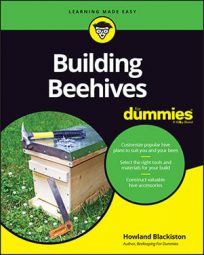When building a hive-top feeder, it's easiest to break it down into its individual components — the following tables show you how and provide instructions on how to cut those components. Separate cut sheets for ten- and eight-frame Langsrtoth hives are included. The assembly instructions for each are identical.
Lumber in a store is identified by its nominal size, which is its rough dimension before it's trimmed and sanded to its finished size at the lumber mill. The actual finished dimensions are always slightly different from the nominal dimensions. For example, what a lumberyard calls 1 inch x 4 inch lumber is in fact 3/4 inch x 3-1/2 inch.
The Material column in the following table lists nominal dimensions and the Dimensions column lists the actual, final measurements.
This design makes use of dado and rabbet cuts.
| Quantity | Material | Dimensions | Notes |
|---|---|---|---|
| 2 | 1" x 4" clear pine | 19-7/8" x 3-1/2" x 3/4" | These are the long side boards of the feeder. Cut a 1/4" wide by 3/8" deep dado along the entire length of the side boards, 1/2" from the bottom edge. Dado two channels 3/4" wide by 3/8" deep along the long dimension of the side boards. Space the dado cuts 3/4" apart at the center mark of the side boards. Rabbet 3/4" wide by 3/8" deep along both ends of the boards. |
| 2 | 1" x 4" clear pine | 15-1/2" x 3-1/2" x ¾" | These are the short side boards of the feeder. Cut a 1/4" wide by 3/8" deep dado along the entire length of the side boards, 1/2" from the bottom edge. |
| 2 | 1" x 4" clear pine | 15-1/2" x 2-1/2" x 3/4" | These are the shallow entrance walls to the feeding area. |
| 2 | 1" x 4" clear pine | 14-3/4" x 2-5/8" x 3/4" | These are the deep entrance walls in the feeding area. |
| 2 | 1/4" lauan plywood | 15-1/2" x 9-1/4" x 1/4" | This becomes the "floor" of the feeder. |
| 2 | #8 hardware cloth | 14-3/4" x 5" | These are the screened inserts for the feeding area. Fold each in half the long way, making a V shape that is 14-3/4" long by 2-1/2" wide. |
| 1 | #8 hardware cloth | 16-1/4" x 5" | This is the screened top for the feeding area. |
![[Credit: Illustration by Felix Freudzon, Freudzon Design]](https://www.dummies.com/wp-content/uploads/357116.image0.jpg)
![[Credit: Illustration by Felix Freudzon, Freudzon Design ]](https://www.dummies.com/wp-content/uploads/357117.image1.jpg)
| Quantity | Material | Dimensions | Notes |
|---|---|---|---|
| 2 | 1" x 4" clear pine | 19-7/8" x 3-1/2" x 3/4" | These are the long side boards of the feeder. Cut a 1/4" wide by 3/8" deep dado along the entire length of the side boards, 1/2" from the bottom edge. Dado two channels 3/4" wide by 3/8" deep along the long dimension of the side boards. Space the dado cuts 3/4" apart at the center mark of the side boards. Rabbet 3/4" wide by 3/8" deep along both ends of the boards. |
| 2 | 1" x 4" clear pine | 13" x 3-1/2" x 3/4" | These are the short side boards of the feeder. Cut a 1/4" wide by 3/8" deep dado along the entire length of the side boards, 1/2" from the bottom edge. |
| 2 | 1" x 4" clear pine | 13" x 2-1/2" x 3/4" | These are the shallow entrance walls to the feeding area. |
| 2 | 1" x 4" clear pine | 12-1/4" x 2-5/8" x 3/4" | These are the deep entrance walls in the feeding area. |
| 2 | 1/4" lauan plywood | 13" x 9-1/4" x 1/4" | This becomes the "floor" of the feeder. |
| 2 | #8 hardware cloth | 12-1/4" x 5" | These are the screened inserts for the feeding area. Fold each in half the long way, making a V shape that is 12-1/4" long by 2-1/2" wide. |
| 1 | #8 hardware cloth | 13-3/4" x 5" | This is the screened top for the feeding area. |

